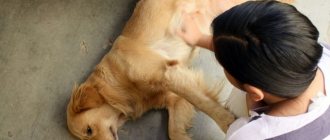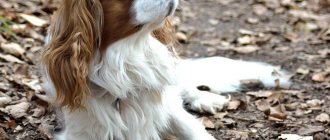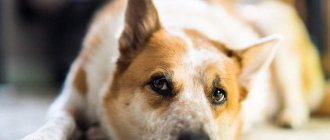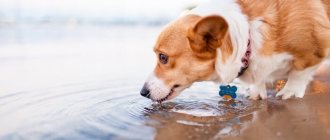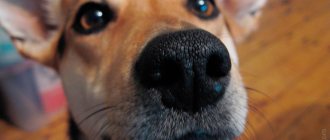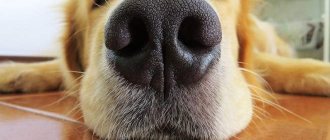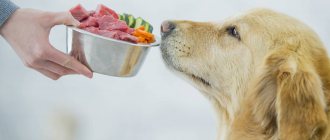What to do if your dog has a dry nose? Is a dry and warm nose a sign of an animal illness? Let's figure this out.
Every owner of a four-legged dog, having noticed changes in the behavior of their dog, first of all feels its nose. If the nose is cold and wet, then everything is in order, but if the nose is dry and warm, then something is wrong. And this is correct, because a dog’s nose is an indicator of its well-being.
But a dry nose is not always a sign that the dog is sick. In most cases, a warm and dry nose is only a temporary phenomenon associated with physiological reasons.
If your dog has a dry nose, don't panic right away. Pay attention to your pet's general health. If the dog is active, cheerful, and has a good appetite, then there is no need to worry.
If, in addition to a dry and warm nose, the dog exhibits symptoms such as lethargy, lack of appetite, fatigue, and gastrointestinal upset, then you need to sound the alarm.
So in what cases is a warm and dry nose in a tail the norm, and when is it necessary to urgently seek help from a veterinary clinic?
Why does a dog have a wet and cold nose?
Why is a dog’s cold and wet nose considered the norm?
The dog's nose, both inside and out, is covered with mucus. About the same as the mucus inside every person's nose. Mucus is produced by glands lining the nose. With the help of this mucus, the nose of the moth can detect the faintest odors and movements of air masses. Most of the nasal mucosa is very well supplied with blood, which allows you to change the temperature of the air the dog inhales.
The nose is also a filter against bacteria, viruses and dirt. And in order for the pet to feel good, to catch the slightest air breaths and smells, the nose must be moist.
Dry nose - special attention
If the nose is not wet and hot for a long time, then the owner’s attention is required.
Signs accompanying organ dryness:
- Apathy, lethargy, lack of desire to play and walk,
- Animals that feel unwell try to hide in secluded places,
- Lack of appetite, refusal of water or vice versa, increased thirst,
- Increased body temperature
- Hot ears
- Colds: sneezing, nasal discharge, coughing, watery eyes,
- Increased or slowed breathing and heart rate.
Obvious signs that require taking your animal to the veterinarian:
- Temperature jump to 40 degrees and above,
- Loss of consciousness,
- Cloudy nasal discharge,
- Impaired urination and bowel movements,
- Vomit.
There's no reason to worry
In what cases is a warm and dry nose not a cause for concern?
Age or individual characteristics of the pet
It is not uncommon for small puppies to have warm noses. If in general nothing has changed in the baby’s behavior, then there is no need to worry. The puppy will grow up, and everything will return to normal.
There are cases when some dogs always have a warm nose. This is already an individual feature. It’s just that the nasal mucosa in such animals is “passive”. And for them this is the norm.
The dog is sleeping or has just woken up
Pets that lead a calm and measured life lose the need for anxiety and a sensitive state during sleep. They do not need to be constantly on the alert, worry and catch with their nose the slightest changes in the environment. They sleep calmly and peacefully. The nose is also resting. Therefore, during sleep, the nose is dry. But as soon as the mustache wakes up, everything immediately returns to normal.
Overwork
For several hours in a row, your four-legged animal actively swam, ran and jumped. And when he returned home, he “fell without his hind legs” and does not react to anything. And the nose is dry and warm.
Don’t worry, it’s just that your little toothy has lost strength due to active pastime. He'll rest a little and everything will be fine again.
Stress
A dog can also have a dry nose when it is afraid of something or is nervous. Monitor your pet's emotional state. Try to provide him with the most comfortable and calm environment possible.
Weather
Extreme heat or cold can also cause a dry, warm nose. Under the scorching rays of the sun, the skin on a dog's nose, like a person's, can burn.
In extreme heat, try to provide the animal with the most comfortable conditions possible: shade, plenty of drink and access to water. How to do this, read about how to protect your dog in the heat.
The same applies to severe cold. Severe frost can cause your nose to become dry and even cracked.
Microclimate in the house
Sudden temperature changes, air conditioning and heating very dry the skin. If the air in the apartment is dry, not only the dog, but also everyone in the household will have problems with dry skin.
Pregnant or lactating bitches
A warm and dry nose in pregnant or lactating bitches is considered normal.
We've looked at cases where a warm, dry nose is not a cause for concern. Now let's talk about when a pet's dry nose is a sign of a particular disease.
Bacterial infection of the deep layer of skin
Occurs when microbes enter deep into the dermis.
Furuncle
First, a painful node appears, then an abscess matures in its center. After 5–7 days it opens, a purulent-necrotic core is released, and the wound is scarred. When there is more than one lesion, they speak of furunculosis.
Carbuncle
These are several boils united into a common infiltrate. The place looks like a purple-bluish tumor. Pain increases, well-being suffers, body temperature rises. After opening the formation, a deep ulcer remains, healing with a scar.
Cause for concern
Below are considered cases when an animal's warm and dry nose should alarm the owner.
Allergy
Allergies are the most common cause of a dry nose. It can manifest itself on anything: food, dishes, vitamins and nutritional supplements, incorrectly selected medications, flowering plants, household chemicals, and so on.
In addition to a dry and warm nose, allergies are accompanied by additional symptoms: redness of the eyes and ears, itching appears, the dog begins to itch, the skin dries and dandruff appears, the hair dries out and falls out. I recommend reading about other causes of hair loss in animals.
In this situation, it is important to find out what was the cause and eliminate the allergen from the pet’s life. If tests fail to detect the type of allergy, then you will have to gradually, step by step, by eliminating a particular product or material, identify what caused the disease.
Cold
If your dog has a cold, then in addition to a dry nose, it may also show other signs of illness: the animal sneezes, coughs, runny nose, wheezing is heard while breathing, the dog sleeps a lot, there is apathy to everything that is happening around, loss of appetite, body temperature rises.
First of all, it is necessary to measure the dog’s body temperature. If it is higher than normal, then this indicates an inflammatory process in the dog’s body.
In this case, there is no need to self-medicate, there is no need to “warm up the dog” and do mustard plasters. This way you can only harm the already weakened health of your tail. Seek help from a veterinary clinic immediately.
Injury
If your dog has a dry nose, then the animal may have been injured. Monitor your pet's well-being. Inspect it for scratches, abrasions or splinters. If there are no visible injuries, but the dog is limping or acting differently than usual, contact your veterinarian.
Pemphigus
Pemphigus is a disease of the immune system. Bubbles appear on the nose in which fluid forms. When the bubbles burst, the liquid flows out, and when it dries, a crust forms that covers the entire nose and prevents the animal from breathing.
Only tests can confirm or refute the disease.
Worms
Parasites in a dog’s body are not just dangerous, they are deadly. Worms eat body tissue from the inside. When infected with worms, the animal experiences lethargy, vomiting, changes in body temperature, bulging abdomen, and a dry and warm nose. Worms often lead to blockage and rupture of the intestines.
To prevent this from happening, it is necessary to deworm the animal once every 3-4 months.
Plague
Distemper is a rapidly progressing and deadly disease for animals. It is characterized by symptoms such as a hot nose, lethargy, purulent nasal discharge, diarrhea and vomiting with foam, and refusal of food and water.
At the slightest sign of infection, you should immediately contact a veterinarian. To eliminate the possibility of contracting this disease, be sure to vaccinate your dog annually.
Rabies
Rabies is the most dangerous and incurable disease. Both unvaccinated animals and people are susceptible to infection.
For people bitten by an infected animal, treatment is difficult and long. But four-legged animals, unfortunately, cannot be treated. Infected dogs are immediately euthanized.
Please read about rabies in dogs, what are the symptoms of this dangerous disease, how is it transmitted and what are its symptoms.
Even if the dog has all its vaccinations, every owner must know the main symptoms of distemper and rabies. The sooner the owner understands that the pet is sick when infected with distemper, the greater the chance of curing the dog. In the second case, it will most likely not be possible to save the animal, but you need to think about the safety of others.
Treatment
In case of injury. It is necessary to stop the bleeding. Identify the cause and location of the injury and disinfect the area. If necessary, administer anesthetic and apply stitches. Take medication that will promote further healing. Preparations: Lysozyme, Travmatin, Ranosan, etc.
When dehydrated. Force drink water using a syringe. Apply a dropper with glucose solution. If necessary, then medications.
For allergies. If you have a food allergy, then choose a diet that excludes those foods that cause an allergic reaction. If you are allergic to fleas, use collars and special shampoos. With Atopic allergies, the animal cannot be cured, but with the use of certain medications, vital signs can be improved. Medicines: Antihistamines.
With vitamin deficiency. Review and recalculate the animal’s diet, balancing it.
In case of poisoning. It is possible to wash the gastrointestinal tract with potassium permanganate. Preparations: vitamin B6, adsorbents.
For helminths. Anthelmintics.
For colds. Depending on the type of cold, take certain medications. Medicines: antibiotics, vitamins, immunostimulants, anti-inflammatory and expectorants.
Pet owners should understand that self-medicating their pet is very dangerous, this can lead to a deterioration in its condition, or, in the worst case, death.
Let's sum it up
A dog's dry nose is not a reason to panic. Watch your tailed pet. If he is active, cheerful, has a good appetite, excellent skin and coat condition, normal body temperature, smooth and even nose skin, and he breathes normally, then there is no reason to worry.
If the nose peels, cracks, becomes covered with blisters and scabs, breathing is difficult, extraneous sounds appear (coughing, wheezing, sneezing), the animal’s body temperature is increased or decreased, the dog refuses to eat, hides in a corner, constantly itches, the fur is disheveled and begins to fall out , extraneous symptoms appear (such as diarrhea, vomiting, and so on), in which case you need to urgently run to the veterinarian.
I hope the facts listed will help you figure out whether in one case or another a dry and warm nose in a dog is a sign of a disease or a normal reaction of the body.
Take care of your pets! And let your beloved little tail always have a cold and wet nose!
What should the owner do?
Don't panic if your pet suddenly has a dry, warm nose. At first, you need to observe his behavior, see how active he is, whether he has an appetite, etc. If everything is in order, then the dryness is short-lived and will soon pass. If a warm nose is observed for a long time, and the animal’s condition gradually worsens, it is necessary to measure the temperature. If the readings are more than 38.5, you should take the animal to the veterinarian: this temperature indicates the occurrence of some kind of disease.
If the temperature is critically high (above 40°C), first of all it is necessary to bring it down and only then take it to the clinic.
First of all, it is important to pay attention to the behavior and well-being of the dog, and not to the dryness of the nose. If the pet is alert and active, then this is a temporary phenomenon caused by natural causes; the owner has no reason to worry. However, if, in addition to this, other symptoms are observed, it is better not to delay a visit to the doctor. The sooner you start treatment, the faster your pet’s condition will improve.
The eighth reason is allergies
Among the pathological causes of dry nose in a dog, an allergic reaction is distinguished. In the vast majority of clinical cases in veterinary practice, an allergy to food components is diagnosed. But, in addition to food allergies, the animal may develop a specific reaction to food additives, household chemicals, pollen from flowering plants and some medications.
The allergy is manifested by dry nose, changes in its temperature and severe itching. In addition, it is noted:
- redness in the ear area;
- scratching on the body;
- the appearance of dandruff, hair loss;
- depressed or, on the contrary, overly excited state of the animal.
In severe cases, an allergic reaction causes swelling of the mucous membranes, especially when bitten by poisonous insects. The very first thing the owner should do is try to determine what caused the allergy. As a rule, in this case, dry nose is relegated to the background, as a number of other symptoms are present. Establishing an accurate diagnosis and determining treatment tactics must be carried out in a clinical setting.
The ninth reason is respiratory tract diseases
Colds are another reason that can cause dry nose. Hypothermia and weakened immune defense provoke a lot of other symptoms. The sick dog has:
- loss of appetite;
- increased body temperature;
- apathetic states;
- discharge from the nasal passages, first serous, and in advanced cases, purulent exudate;
- severe sneezing and coughing.
To understand that the animal is lethargic due to an increase in temperature, it is necessary to measure the indicators. This is done by the rectal method. If the values are above normal, it can be argued that a pathological inflammatory process has developed in the body.
Self-medication can cause complications, so you need to contact a veterinary hospital. It is especially dangerous to use traditional methods of treatment intended for humans, for example, applying mustard plasters, if the dog has a suspected cold.
Prevention
As preventive measures to protect your pet from possible dangers, it is recommended:
- Avoid plastic bowls and keep them clean. Give preference to ceramics or aluminum. They do not cause allergic reactions and prevent the increased growth of bacteria. Wash the feeders after each meal without adding detergent.
- Choose high-quality food and monitor the reaction of the dog’s body. When feeding natural foods, introduce new food gradually, studying the puppies' well-being.
- Use sunscreen not only for yourself, but also for your four-legged friend. In hot weather, lubricate your nose with it, and in winter, moisturize the mucous membrane with vegetable oils.
- Do not walk your dog near allergenic plants during the flowering period.
- Attend veterinary examinations, deworming and vaccinations in a timely manner.

